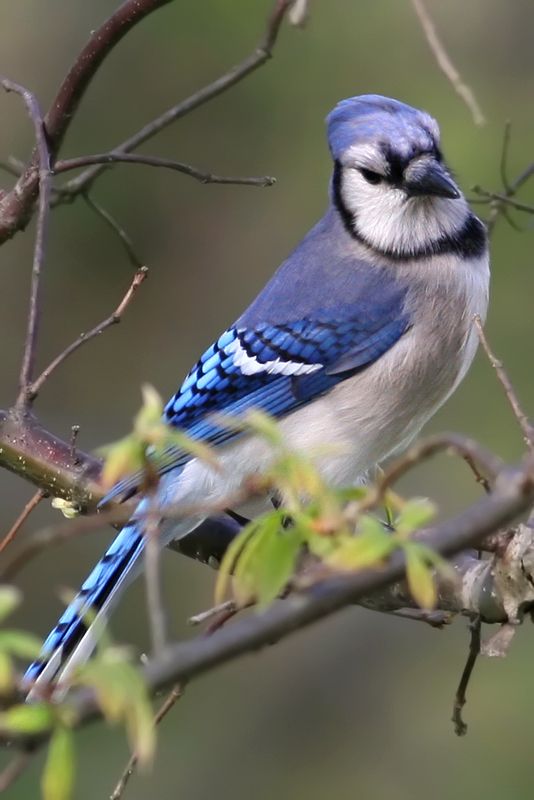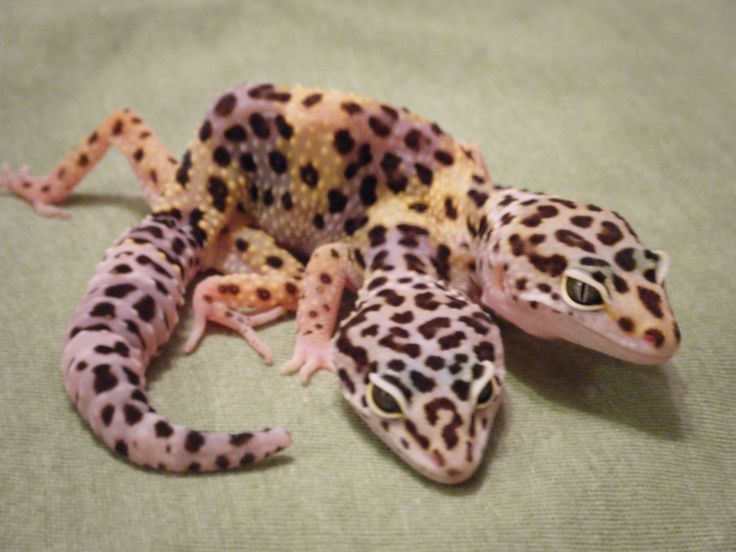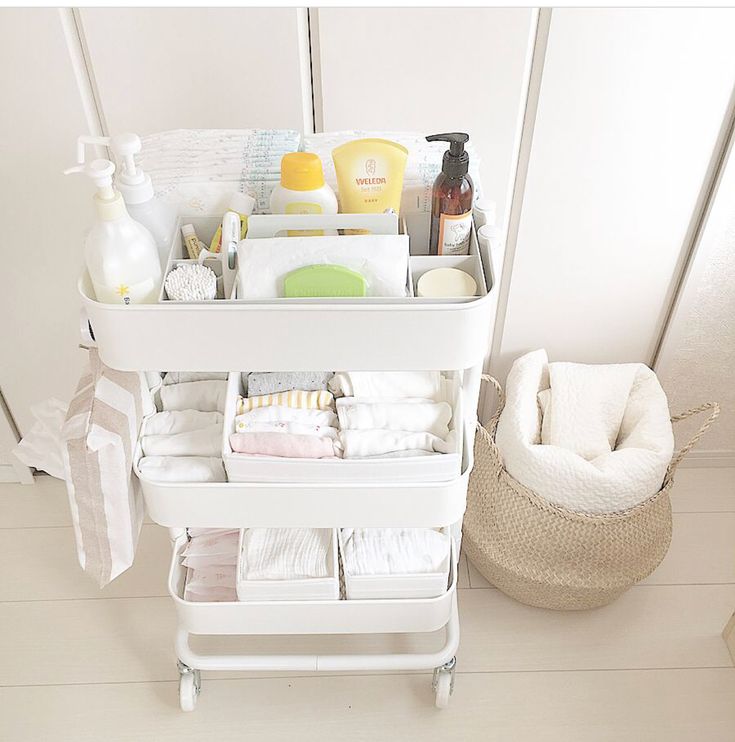Food for baby flowerhorn fish
What To Feed Baby Flowerhorn? Let's Find Out!
Baby Flowerhorn or fryling are fragile and vulnerable. They need special care and attention in the initial days for long-term health. Nurturing your frylings at the beginning of their life includes their feeding too. Do you know what to feed your baby flowerhorn?
Why My Fish Is Not Moving? What Can...
Please enable JavaScript
Why My Fish Is Not Moving? What Can I Do?
You have to feed different food to your baby flowerhorn, such as infusoria, brine shrimp, hard-boiled egg yolk, and crushed pellets. Then, slowly you step to feeding brine shrimp, frozen bloodworms, daphnia, mosquito larvae, etc. Finally, you can even feed powder food.
The information above might confuse you, and any queries related to food might arise. Thus, to get more information about feeding baby Flowerhorn, I suggest you go through this article to the end. I hope you find this article helpful.
Table of Contents
What To Feed Your Baby Flowerhorn?
Well, babies are always vulnerable, and you need to allocate more time to them than adult fish. You need to take precautions and feed them properly to avoid any epidemic or loss.
You need to feed different food at different stages to ensure rapid growth, including the baby stage of flowerhorn. For this, I have differentiated food depending upon the ages of fryling or baby Flowerhorn.
After Hatching To 4-5 days
They still possess egg sacs until the fry reaches the free-swimming stage or four to five days. This egg sac provides nutrients to the newly hatched frying. Thus, you don’t have to feed anything extra till then.
One To Two Weeks
Start feeding with infusoria, hard-boiled egg yolk, etc. You can eventually introduce baby brine shrimp. Likewise, you even can feed powdered or crushed fish pellets. You have to feed 4-10 times per day as the nutrient requirement of fryling is very high.
Feeding this often might pollute water; thus, you need to change water frequently.
After First Few Weeks
The nutritional requirement of the fry will increase at this point in age; thus, you need to increase the quantity and quality of the meal. By saying this, I suggest you introduce a high protein diet like live daphnia, scuds, or small shrimp species.
By saying this, I suggest you introduce a high protein diet like live daphnia, scuds, or small shrimp species.
The growth rate of each fry is not the same. Thus, at this point, you need to separate bigger flowerhorn babies and smaller ones.
Two To Three Months
Here, you can introduce flake food, worms like blackworms and white worms, and other meat products like crickets, mealworms, bloodworms, Mysis shrimp, etc.; these foods are available in live form and frozen and dried forms.
What Are The Benefits Of Feeding Baby Flowerhorn?
Food is the energy source for all living creatures. Therefore, there are immense benefits to feeding your baby Flowerhorn. I have jotted down some of the benefits.
Energy And Bodybuilding
The food you feed to your fry will either provide energy or help in growth. Carbs, protein, and fat from different sources of food such as fruits, veggies, pellets, and meat: frozen, dried, or live, provide an adequate amount of energy and helps in the bodybuilding of Flowerhorn.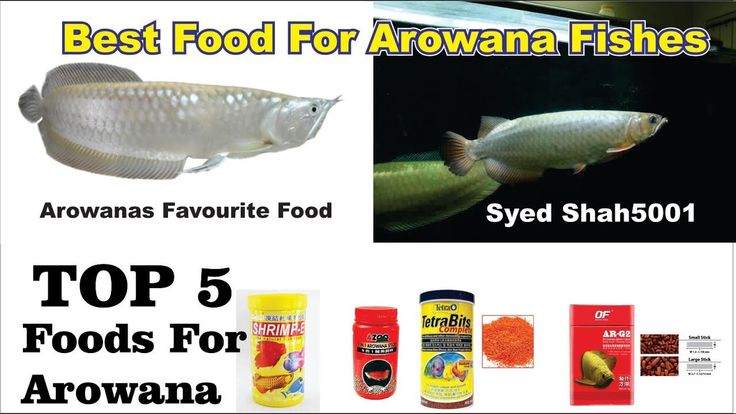
Growth And Development
Food is the most important for the growth and development of your Flowerhorn. You need to meet the nutritional requirements of your Flowerhorn for its rapid growth and sustained life. You may lose your fry when you don’t feed adequate food to your Fry.
Growth Of Hump
Hump slowly starts to grow in Flowerhorn fry. When your Flowerhorn reaches 1.5 inches, the hump starts to develop. You have to feed a proper meal to see the growth of hump in your Flowerhorn fry.
Color Enhancement
Quality of diet and quantity of feed directly impacts the color of your Flowerhorn. As the fry grows, the color also enhances, but the color fades away without proper feed. As a result, the vibrant color will not appear in your Flowerhorn, certainly disappointing you.
Control Aggressiveness
As Flowerhorn is naturally more aggressive than other fish breeds, delay of feed creates more aggressiveness in your Flowerhorn. They will show aggressiveness in other tank mates, normally another fryling in the tank. That might even lead to the death of some baby Flowerhorn.
That might even lead to the death of some baby Flowerhorn.
What Are The Disadvantages Of Overfeeding Baby Flowerhorn?
Overfeeding is not good for your baby flowerhorn and the tank’s environment. Overfeeding causes many digestion problems and other ample disadvantages to your baby Flowerhorn. I have listed some of those negative effects below.
Digestion Problems
Overfeeding does hamper the digestive system of your baby Flowerhorn. Although your baby Flowerhorn’s nutritional requirement is more, overfeeding does no good to them. Indigestion problems, constipation, and bloating might result from overfeeding.
Contaminates Tank’s Environment
The leftover food from the baby Flowerhorn goes and settles down on the substrate, which results in polluting water. The contaminated water enhances infections among the fry, which is already fragile.
You need to clean the tank often if you overfed fry. This creates an unnecessary workload for you and stresses out your fry too.
Encounters Infection
Overfeeding might lower the immunity of your Flowerhorn; thus, they might encounter infections easily. Bad rearing practices and lack of sanitation too lead to infection. Moreover, the leftover food in the tank aids in incrementing ammonia, enhancing the foul smell.
How Often Should You Feed Baby Flowerhorn?
Whether a baby human, animal, or fish, growth is rapid in the initial days after birth, to support this rapid growth, you need to provide sufficient food to your baby Flowerhorn.
During the initial weeks after hatching, you have to feed around 4 times per day. As the nutritional requirement of the fry is high, you should give more time and care to the fry.
As the fryling grows, you can eventually reduce the feed times to 3 times a day until it becomes an adult. It is so because your adult Flowerhorn needs a minimum gap of eight hours between meals to maintain a healthy digestive system.
What Is The Best Food For Baby Flowerhorn?
Despite the variety of food, you can feed the fryling, there is some really good food for the baby Flowerhorn. This includes live foods. Although there are other good foods and you can feed those too, here I am only talking about the best.
Live Food
Live foods are the best source of proteins and essential nutrients like vitamins and minerals. You probably might know that live food is away from processing; they contain trace minerals.
Moreover, Flowerhorn enjoys live food due to the activeness of food. Live food like brine shrimp, daphnia, super worms, mosquito larvae, bloodworms, earthworms, etc.
Live food has an extra advantage that does benefit your fry more than any other form of food due to its freshness and liveliness.
Despite ample benefits, these live foods are capable of transmitting parasitic infection. Thus, you need to ensure that they are free from such infections and buy from an authentic food store.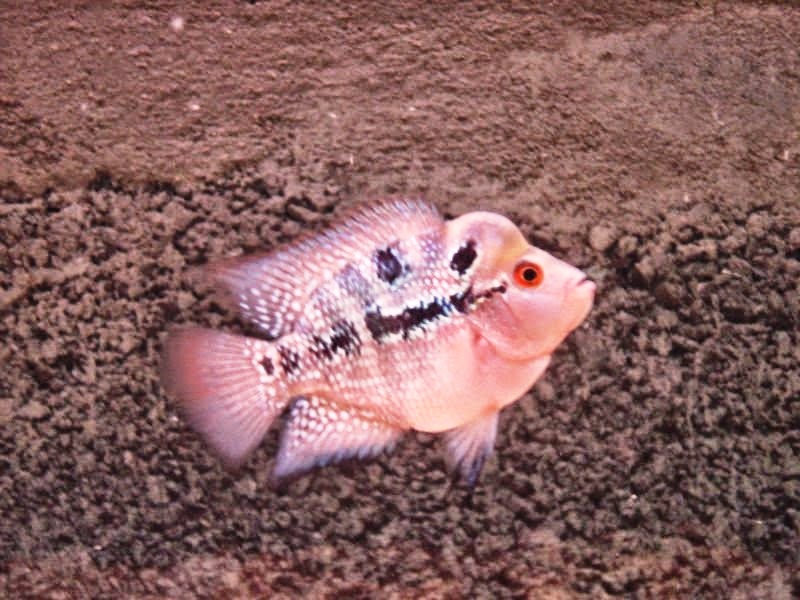 Here are some of my recommendations for live as well as freeze-dried flowerhorn food.
Here are some of my recommendations for live as well as freeze-dried flowerhorn food.
- Hikari Flowerhorn Fish Food
- OKIKO flowerhorn Cichlid Fish
- Fluval A6581 Bug Bites Cichlid Pellets
- Amzey Dries Shrimp Fish Foods
- Appetizing Shrimp Mealworms
- Tetra Jumbokrill Jumbo Shrimp
What Are The Points To Consider While Feeding A Baby Flowerhorn?
There are great points that you should consider while feeding your baby Flowerhorn. Fryling is naturally vulnerable and is at risk. Due to this reason, fish keepers like you should provide a little more care to them and consider the following points while feeding frylings.
- You need to consider the amount of feed as per the nutritional requirement of frylings.
- A number of times, you should feed them. You can feed fries 2 or 3 times per day.
- It would help if you kept in mind the types of food you need to avoid.
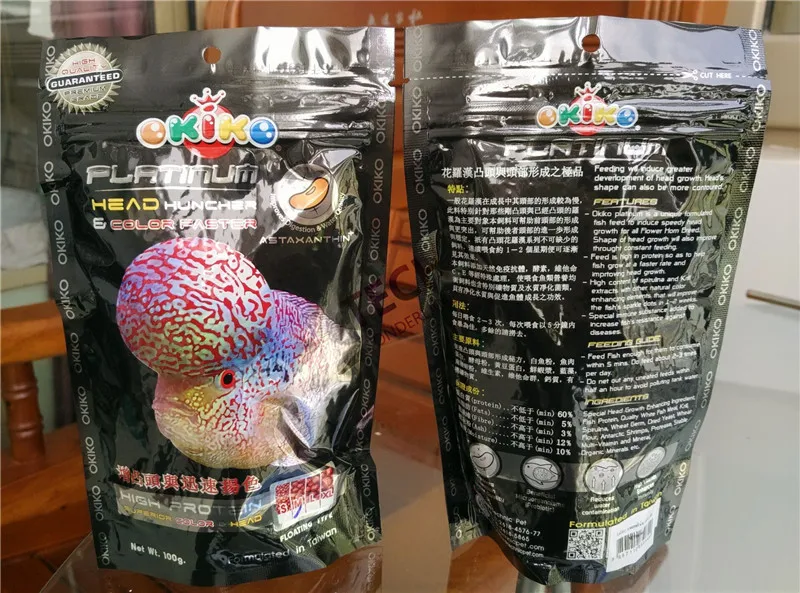
- Need to know the categories of food that help in the smooth growth and development of your Flowerhorn.
- It would help if you observed whether each fry is getting enough food or not.
How To Know You Are Overfeeding baby Flowerhorn?
Whenever you overfeed your baby Flowerhorn, they will show less interest in the food. They become less active than usual, lose aggressiveness and feel uncomfortable.
The other way that you know you overfed your fryling is to see if any food particles are at the bottom of the tank or not. Food excess than requirement settles down on the substrate and contaminates the water.
Mind extra particles in the tank; these particles release toxins by clogging the filter. Hence you should strictly avoid overfeeding your fryling.
FAQs
How To Make A Baby Flowerhorn Grow Faster?
Growth depends on diet, nutrition, and environmental factors like temperature, pressure, pH, etc. Even hygiene and sanitation of the tank, water quality, and filtration either directly or indirectly affect the growth of Flowerhorn.
Even hygiene and sanitation of the tank, water quality, and filtration either directly or indirectly affect the growth of Flowerhorn.
You have to introduce healthy, nutritionally rich food in the proper amount and time to make them grow faster. Likewise, you also have to change the water frequently, maintain incorrect pH and temperature and ensure sanitation of the tank for the faster growth of the baby Flowerhorn.
How To Decrease The Death Of Baby Flowerhorn?
The death of a baby fish indicates so many things. First, it questions the nitrogen cycle, tank size, and tank mates with which you are keeping your fry.
Likewise, fish death even doubts water parameters like temperature and pH. Among these many factors, the disbalance of a single parameter might result in the death of the fryling.
In addition to this, the tank’s inadequate diet and filthy environment are the basic things that might also result in the death of baby Flowerhorn.
Thus if you master these parameters and maintain a healthier tank environment, you can reduce the death of your fryling.
How To Maintain A Favorable Environment For Baby Flowerhorn?
You need to ensure that your tank has good filtration. Also, make sure the water quality in the tank is good enough, along with the size of the tank.
You have to observe whether the baby Flowerhorns are getting enough space in the tank for mobility. You can even maintain a favorable environment for baby Flowerhorn by changing the water regularly.
All these reduce the chances of infection in the tank and maintain a healthy environment for baby Flowerhorn.
Conclusion
As baby Flowerhorn is very fragile and needs special attention, you need to take care of their diet. You can feed them a highly nutritious, proteinous diet for proper and smooth growth and development. Live food like brine shrimp, daphnia, super worms, mosquito larvae, bloodworms, earthworms, etc., are the best source of protein. You can even feed fish pellets, powered frozen, sun-dried, and other commercialized fish food, ensuring your fryling meets its nutritional requirement.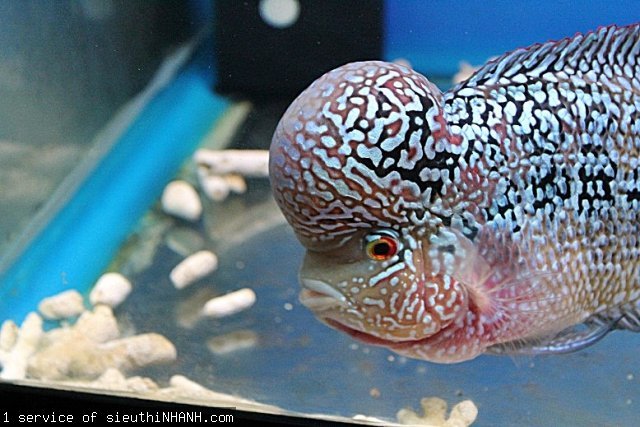
I hope this article addresses all your queries about feeding Flowerhorn fry or baby. For more information on Flowerhorn and other fish breeds, you can visit our website, Fishkeeping guide.
Happy Fishkeeping!
The Best Food for Flowerhorn in 2022
All flowerhorn keepers know just how hard it is to keep this species of fish. You need to keep the parameters of the tank and water just right. Of course, you will also need to provide them with the best food for flowerhorn. The right food will keep them looking and feeling healthy.
The flowerhorn is one of the most popular types of freshwater aquarium fish, so there are also a lot of brands of food for them. This article will give you a couple of pointers on how you can choose the right product. It will also provide you with a couple of product reviews to gain some insights into different brands.
After reading, you will know pretty much everything that’s needed to make an educated decision when shopping for the best flowerhorn fish food. Here’s to hoping that your flowerhorn will enjoy what you will be getting for it.
Here’s to hoping that your flowerhorn will enjoy what you will be getting for it.
Contents
- Best Food for Flowerhorn Reviews
- 1. Hikari Flowerhorn Fish Food
- 2. OKIKO flowerhorn Cichlid Fish Food
- 3. Fluker’s Freeze Dried Reptile Treats
- 4. Ocean Pellets Humpy Head Xo Flowerhorn Food
- 5. Appetizing Shrimp Mealworms
- 6. Tetra JumboKrill Jumbo Shrimp
- 7. Amzey Dried Shrimp Fish Foods
- 8. Fluval A6581 Bug Bites Cichlid Pellets
- What to Look For When Buying a Food For Flowerhorn
- Frequently Asked Questions
- Conclusion
Best Food for Flowerhorn Reviews
1. Hikari Flowerhorn Fish Food
This particular product contains a well-calculated amount of red chili pepper. This will enhance the red coloration of flowerhorns. I have been feeding my flowerhorn with it for a little over three months and the improvement in its color has been so drastic. If you were to check its before-and-after pictures, the positive change is so noticeable.
This fish food is not just for good looks but will also greatly improve the overall health of your fish. One of the most important ingredients in this product is stabilized ascorbic acid. This helps in boosting the immune system of the fish.
Aside from vitamins and minerals, this fish food also contains a good amount of beneficial gut bacteria. These bacteria will inhabit the gut of the fish and help break down food more efficiently.
In other words, your flowerhorn will be able to absorb more nutrients from the food it eats. Because the fish breaks down its food more efficiently, you can expect the creation of only minimal waste.
I have a very picky flowerhorn. It will only eat a handful of brands of fish food and I am fortunate that I discovered this product as it is one of those that they like. It must be the freeze-dried krill meat that makes this food so appealing to my flowerhorn.
You would think I have not fed him the morning before. The reason is when it is time for the afternoon feeding, he would lunge at this food like he is completely famished.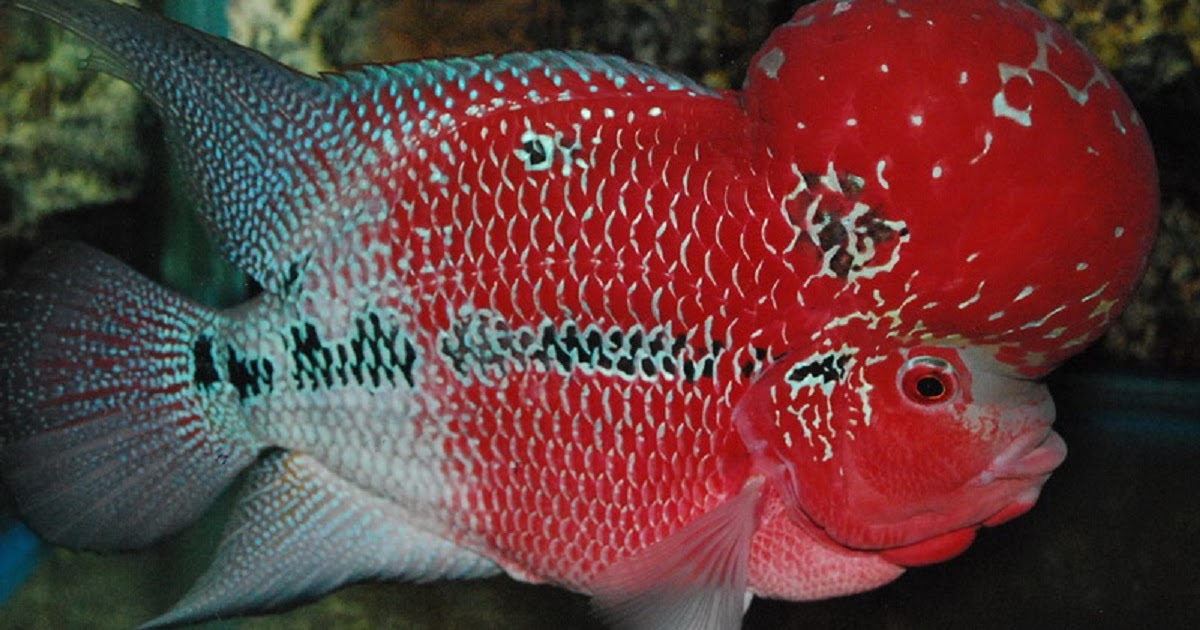
I do have a couple of issues with this product but the biggest one is that it quickly clouds the water. Even when you are just picking a pellet out of the jar, it is already starting to fall apart. You need to feed your fish just enough food that it can eat in around five minutes or so and then fish out the leftovers.
Pros
- Contains chili pepper, which helps enhance the color
- Fortified with Vitamin C for enhanced immunity
- Contains live beneficial bacteria to bolster digestion
- Very flavorful – I noticed that even picky eaters love it
Cons
- Has a very strong smell
- Clouds the water
Of course, you want your flowerhorn to look the best that it can be and this fish food will do just that. In just a little under two months, your flowerhorn will have a bright, blood-red hue that you have always wanted for it. Not only will your fish look healthy but it will also actually feel it.
2. OKIKO flowerhorn Cichlid Fish Food
I highly recommend this fish food if you have a juvenile flowerhorn as this would greatly aid in their proper growth and development.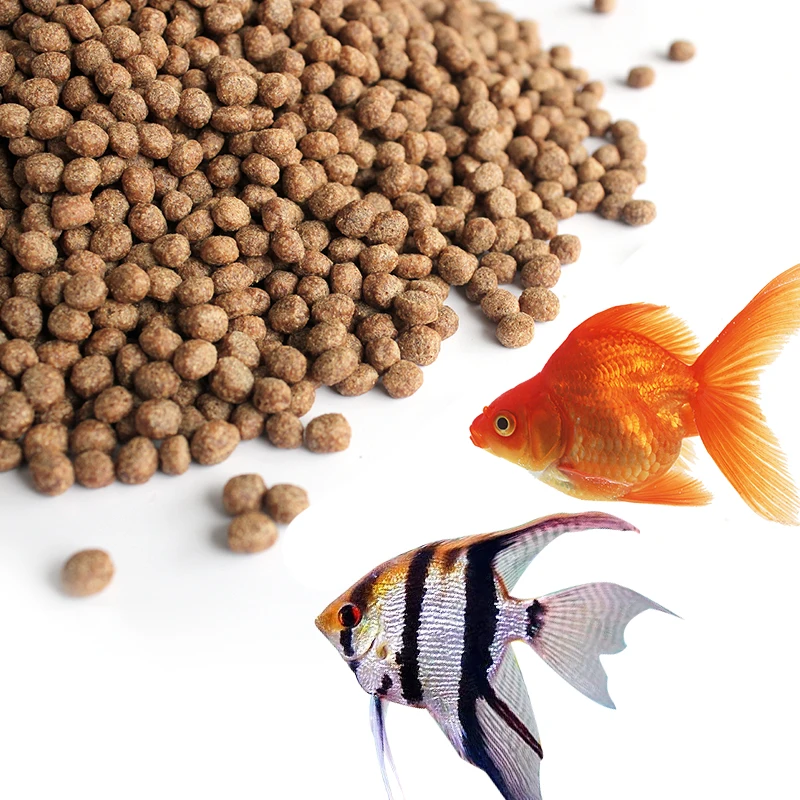 A couple of months of feeding your young flowerhorn with this choice for the most suitable food for a flowerhorn baby will result in a bigger crest and brighter coloration.
A couple of months of feeding your young flowerhorn with this choice for the most suitable food for a flowerhorn baby will result in a bigger crest and brighter coloration.
I have been feeding my flowerhorn with this for almost two months and it now looks a whole lot different compared to when I first started.
One of the reasons this product is highly recommended is its high protein content. This fish food contains a lot of krill, which is a good protein source and lends flavor. This also contains spirulina, which is a superfood that aids in digestion and bolsters the immune system.
I also discovered that this product is a floating type of fish food, which makes it easier for flowerhorn and other surface feeders to eat. In addition, even after the fish finish eating, the leftovers will remain floating on top of the water. This makes cleaning up later a lot easier.
Another reason why I consider it one great choice for flowerhorn fry is that it does not easily break apart in the water. This means I won’t have to deal with a cloudy aquarium after every feeding session. Even after half an hour has passed after the fish finish eating, the pellets stay intact and afloat on top of the water.
This means I won’t have to deal with a cloudy aquarium after every feeding session. Even after half an hour has passed after the fish finish eating, the pellets stay intact and afloat on top of the water.
Here is the biggest issue that I have with this product. It is labeled as large but the pellets are more medium-sized if anything. This is important because they are much too small for fully-grown flowerhorns. The pellets need to be at least twice their size for mature flowerhorns to eat them properly.
Pros
- Contains a lot of protein, thereby promoting faster growth
- Contains spirulina and krill – both of which help in improving coloration
- Floats on the surface for easy feeding
- Does not break apart easily and does not cloud the water
Cons
- The pellets are too small for full-grown flowerhorn
- Comes with broken English instructions and written details
If you have a young/juvenile flowerhorn, this fish food will greatly aid in its growth and development.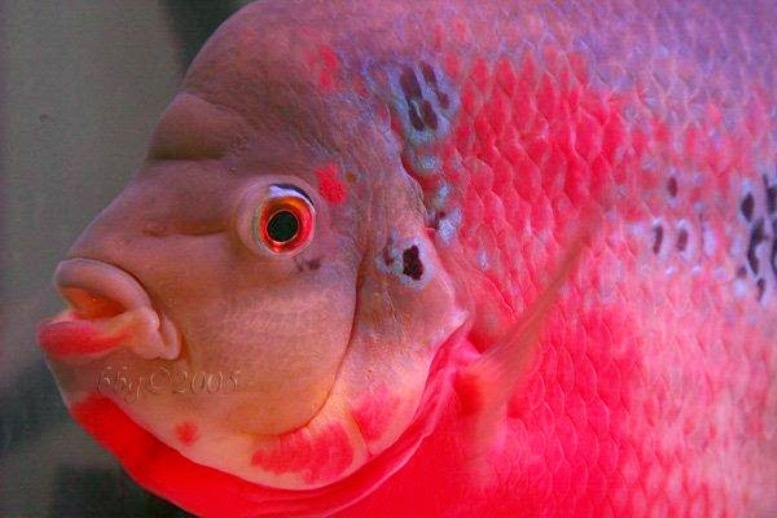 However, once your fish fully matures, the pellets will be too small for them. This would have been better if the pellets were the “large” size that was printed on the label.
However, once your fish fully matures, the pellets will be too small for them. This would have been better if the pellets were the “large” size that was printed on the label.
3. Fluker’s Freeze Dried Reptile Treats
Flowerhorns, just like any other large cichlids, need a lot of protein to maintain their body mass and promote optimum health. There are few other better sources of protein for fish other than dried shrimp.
This product contains nothing more than natural, dehydrated river shrimp, which is a good source of natural protein. It also apparently tastes great since my flowerhorn just loves it.
Aside from my flowerhorn, I also keep a couple of turtles. I also have a koi pond and they also love these dried shrimps. The turtles cannot have enough of this. I would throw a couple of shrimps into their tank and they would tear it to shreds. I was also told that axolotls love this food.
I also liked that this product does not contain any dust in the packaging.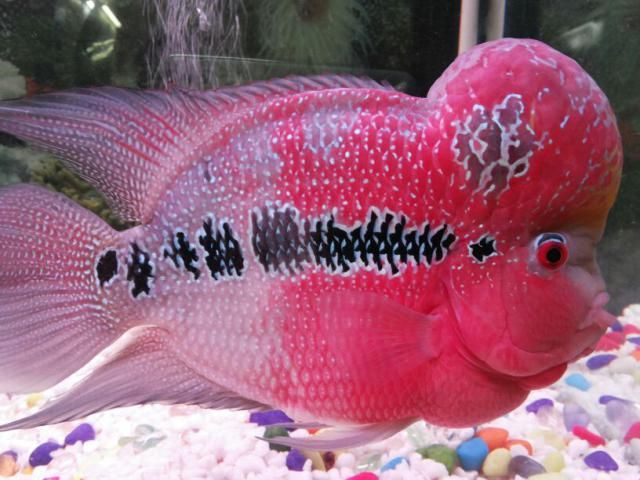 I have had bad experiences with fish food that contained a lot of dust at the bottom of the packaging. This only contains whole dried shrimp and no trace of dust that will only cloud the water.
I have had bad experiences with fish food that contained a lot of dust at the bottom of the packaging. This only contains whole dried shrimp and no trace of dust that will only cloud the water.
These shrimps also underwent proper processing. This means they are all completely dry. There is no chance of mold growing in the packaging. This makes the shrimps easy to crumble, which is important for small fish and reptiles as these might be too big for them.
I would be more enthusiastic in promoting this fish food if only the company had better quality control. The quality of the shrimp they used has dropped significantly in the last couple of batches. The last two jars I have bought from them smelled a bit off and my flowerhorn refused to eat them.
Pros
- Provides a good amount of protein
- Great for feeding reptiles, amphibians, and other aquatic creatures
- Cleanly packaged – You can’t find any dust that adds to the weight
- Completely dried and easy to crumble
Cons
- Inconsistent quality
- The shells are a bit tough
It is quite unfortunate that the quality control of this brand is almost non-existent because I would love to use this all the time.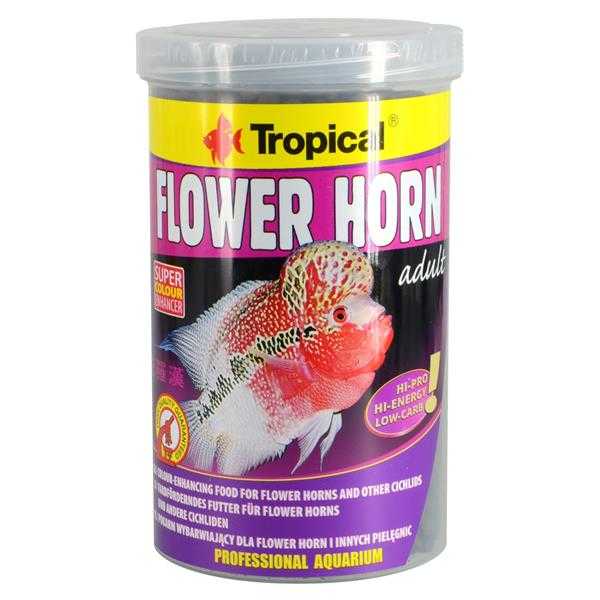 I hope that the future batches would be consistently good quality like they were in the past.
I hope that the future batches would be consistently good quality like they were in the past.
4. Ocean Pellets Humpy Head Xo Flowerhorn Food
Despite having a goofy name, this fish food is quite good at promoting faster growth and development in flowerhorns. It contains a lot of protein, thanks to having krill as one of the main ingredients. This is an ideal feed for juvenile flowerhorns as it will make them grow faster and bigger compared to just feeding them with mealworms and the like.
This product also contains ingredients that promote the growth and prominence of the head bump of the flowerhorn. The hump is the main distinguishing factor of flowerhorns. Genetics is also the factor that mostly determines its size. However, it did seem like this food had a significant effect on the growth of the hump of my fish.
Aside from krill, this fish food also contains spirulina. Spirulina is a superfood that helps improve fish’s digestion and immunity. Moreover, spirulina improves the colors and patterns of the flowerhorn. I have been feeding my flowerhorn with this product for maybe two weeks and it is now a brighter red than it was before.
I have been feeding my flowerhorn with this product for maybe two weeks and it is now a brighter red than it was before.
Aside from my flowerhorn, I also feed this to my other cichlids and they are looking healthier and more beautiful as well. My white Oscar seems to be the one that benefitted the most. Its stripes are now clearer and more vibrant than it was before.
I have only been using this product for a couple of weeks, so I do not have much to complain about. However, because this product is shipped from Singapore, I am a bit worried that there is no customer service number that I can call. Also, it is clear that whoever wrote the details in the back, his first language is not English.
Pros
- High in protein for faster growth
- Contains ingredients that help the flowerhorn’s bump grow larger
- Contains krill and spirulina that help improve coloration
- Other cichlids can benefit from this food
Cons
- Ships from Singapore so customer service might be non-existent
- Instructions are unclear due to being written in broken English
The language barrier problem is understandable given that this product came from overseas. Other than that, I have not had any problems with this product, and I consider it as one of the top foods for Thai silk flowerhorn.
Other than that, I have not had any problems with this product, and I consider it as one of the top foods for Thai silk flowerhorn.
5. Appetizing Shrimp Mealworms
This product is the perfect type of food for making your flowerhorn grow bigger and healthier. It contains dehydrated mealworms and shrimp – both of which are great natural sources of amino acids and proteins. This means that this food can help promote the proper growth and building mass in flowerhorns.
Another nice thing about this product is that it is 100% natural. There are no artificial preservatives or ingredients. This means that it is perfectly safe for your precious flowerhorn. I feed my flowerhorn as much of this product as it can eat and it has not shown any negative reaction whatsoever.
It is also easy to store because it does not require refrigeration. The mealworms and shrimps are all completely dry so you just need to store them in a cool and dry place. I suggest that you transfer the contents into a plastic, airtight container, and maybe throw in a desiccant pack to keep the contents dry.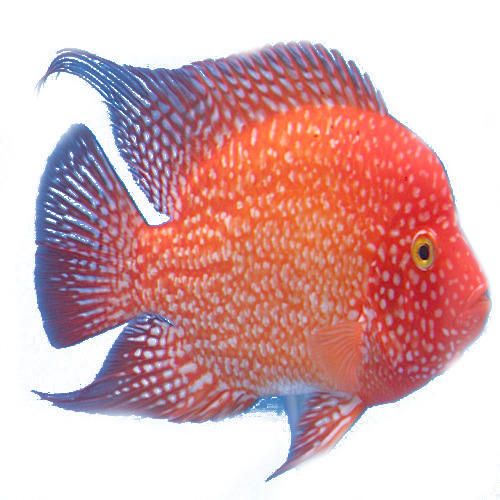
What I liked the most about this fish food is that it does not cloud the water. It is also easy to clean the leftovers. I do not usually need to clean up after my flowerhorn as it often devours all the shrimps and mealworms. However, if necessary, I just have to skim the surface for bits of this fish food.
I do not have any serious complaints about this product, but I have a couple of aquarium-keeping friends that do not like it. They say that their flowerhorns did not like the food and they have to starve their fish to make them eat. I am fortunate that my flowerhorn would eat anything but if yours is a picky eater, it may not like this food.
Pros
- Mealworms and shrimp are rich in amino acids and proteins
- No artificial preservatives added
- No refrigeration required
- Does not cloud the water and flowerhorns just love them
Cons
- Picky eaters may not be fond of eating this food
- Subpar packaging
I would have liked this product better if it came in better packaging, like something that is resealable. Despite this, I liked how beneficial this product is for my flowerhorn. It bulked up quite a lot. I also noticed its color becoming brighter and its patterns getting clearer.
Despite this, I liked how beneficial this product is for my flowerhorn. It bulked up quite a lot. I also noticed its color becoming brighter and its patterns getting clearer.
6. Tetra JumboKrill Jumbo Shrimp
These freeze-dried shrimps contain astaxanthin, which is a natural nutrient that can make fishes’ colors brighter. When I first got my flowerhorn, I thought that it was mostly white with red stripes. After feeding it with this top-rated food for flowerhorn color for several weeks, my fish is now bright red. It also has more pronounced stripes.
Aside from making your fish look brighter, the jumbo krill also contains a lot of protein per pound. This aids in the faster growth of your flowerhorn. This is highly recommended for juvenile flowerhorns as it makes them grow faster and bigger than they would have otherwise.
In addition, the jumbo krill are freeze-dried whole, complete with shells, heads, and legs. Not only does this mean that your fish are getting more than enough calcium but it will also improve your fish’s digestion. This means that the more your fish eats this food, the more efficient its digestion will be.
This means that the more your fish eats this food, the more efficient its digestion will be.
This fish food is not just for flowerhorns. Other fish and animals also liked this a lot. I have a couple of red-eared turtles and sliders and they love this jumbo krill. I also feed this to my bettas but I had to crumble them so that they would fit in their mouths.
The only problem I have with this product is that the packaging contained a lot of shrimp dust at the bottom. There were so many crushed-up shrimps that it seemed like such a waste.
Pros
- Contains natural astaxanthin that promotes brighter colors
- Has a lot of proteins for faster growth
- The freeze-dried krill improves the digestion of the fish.
- All sorts of fish love this fish food
Cons
- The bottom of the can contains a lot of crushed krill, which only clouds the water
- A bit more expensive compared to other similar products
Although this fish food only contains one main ingredient (and a couple of nutritional additives), this is one of the most trustworthy flowerhorn foods I have used. You will be surprised at just how bright your flowerhorn’s colors can be when you feed it with this.
You will be surprised at just how bright your flowerhorn’s colors can be when you feed it with this.
7. Amzey Dried Shrimp Fish Foods
This product consists entirely of freeze-dried shrimp, so you know that it contains a lot of protein. This means that your fish will be able to grow bigger and its crest will be much bigger. The shrimps were also preserved whole, so your flowerhorn will also get quite a lot of fiber from the shells and heads.
The red shrimp also contains a lot of astaxanthin, which is a natural chemical that will improve your flowerhorn’s red coloration. You will be surprised at how much brighter your flowerhorn’s color will be after just a couple of weeks. My flowerhorn started out more orange but now it is completely bright red.
Because the shrimps in this product are completely dried, you do not need to store this in the refrigerator. You just need to tightly close the cap and keep the jar in a cool and dry place. You can probably keep the product for a couple of months after opening, but I do not think there won’t be any more to store after a month.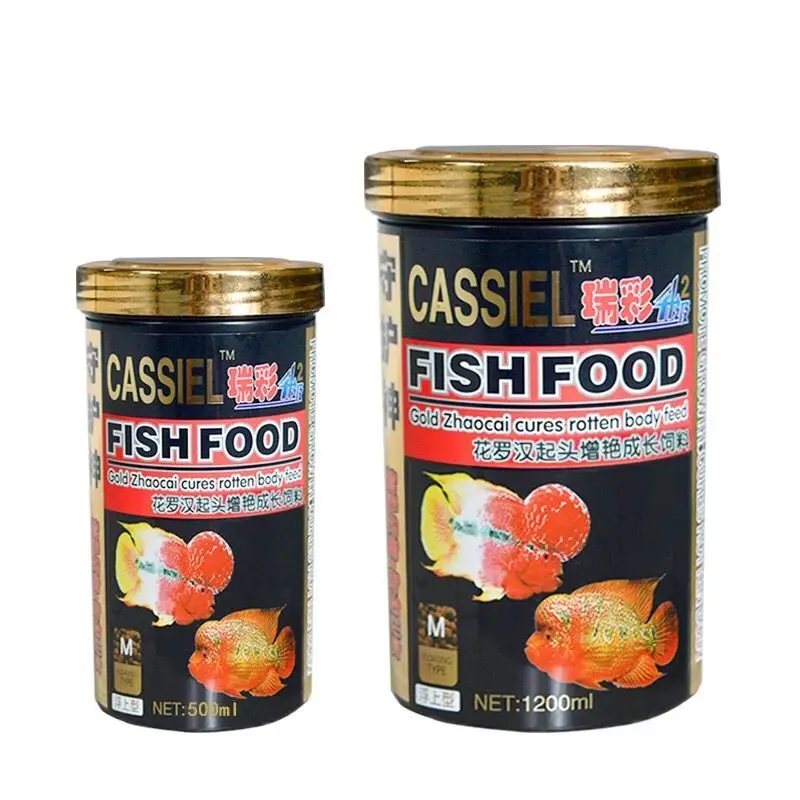
My flowerhorn just loves eating these shrimps, and apparently, it tastes so good that my other fish cannot get enough of it, too. I have a couple of other cichlids in a separate tank and they go into a feeding frenzy for these dried shrimps. I also have several turtles and they also love this product.
Here is something that you need to know about this product – it stinks to high heavens. It is a good thing that this stuff comes in a resealable glass jar because once you open it, the entire room fills with the smell of the beach at low tide.
Pros
- An excellent source of protein and fiber
- Contains a lot of astaxanthin, which promotes brighter coloration
- Easy to store – There is no need for refrigeration
- Pretty tasty apparently
Cons
- Has a very strong smell
- Contains a lot of crushed shrimp
Although this fish food is quite smelly, it does provide a lot of benefits. Although not all my fish would eat this, my flowerhorn could not get enough.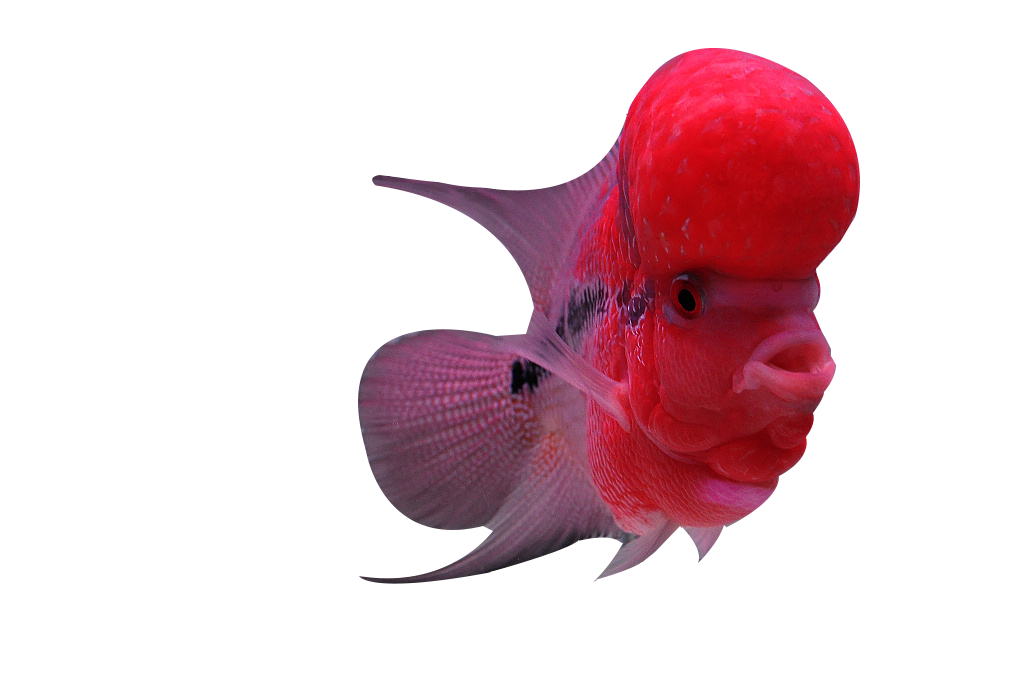 It also looks a lot prettier right now than it was a month or so ago. It has changed so much that you would swear that it was a different fish altogether.
It also looks a lot prettier right now than it was a month or so ago. It has changed so much that you would swear that it was a different fish altogether.
8. Fluval A6581 Bug Bites Cichlid Pellets
The main ingredient of this fish food is freeze-dried black soldier fly larvae. These insects are just chock-full of protein, so much that you need to control how much of it you will feed your flowerhorn. I suggest that you only give your fish this food around 2 to 3 times a week.
Aside from soldier fly larvae, this fish food also contains salmon. Salmon meat contains a lot of protein and is rich in Omega 3 and 6 fatty acids, which improve blood circulation and aid in proper growth and development. This is best for juvenile flowerhorns but if you have one that is recovering from sickness or injuries, this food can also help.
In addition to natural protein, this product also has vegetable fiber. It contains several kinds of vegetables to improve your fish’s digestive system. This means your fish will be able to absorb nutrients from its food better. When your fish can efficiently digest its food, it can produce less waste. The ammonia level in the tank will always be low to zero.
This means your fish will be able to absorb nutrients from its food better. When your fish can efficiently digest its food, it can produce less waste. The ammonia level in the tank will always be low to zero.
The best thing about this product is that it contains sustainably-raised insect larvae. Aside from that, it does not contain any artificial ingredients. This product contains all-natural ingredients and no preservatives, so you can be sure that you are feeding your fish with the right kind of food.
Even though I like this product, I do have a couple of issues with it. First, the size of the pellets is too small for full-grown flowerhorns. My flowerhorn, fortunately, would eat anything, but other fish might ignore these pellets due to them being too small. This leads to my next issue – that is the pellets contain way too much protein for small fish.
Pros
- Contains nutrient-dense black soldier fly larvae
- Has salmon, which is rich in Omega 3 and 6 fatty acids
- Comes with lots of vegetable fiber for improved digestion
- Does not contain any artificial ingredients and preservatives
Cons
- Not ideal for fully-grown flowerhorns
- Too much protein, which is why it is advisable to feed it sparingly to small fish
This fish food contains so much protein that you will see noticeable growth in your flowerhorn after just a couple of weeks.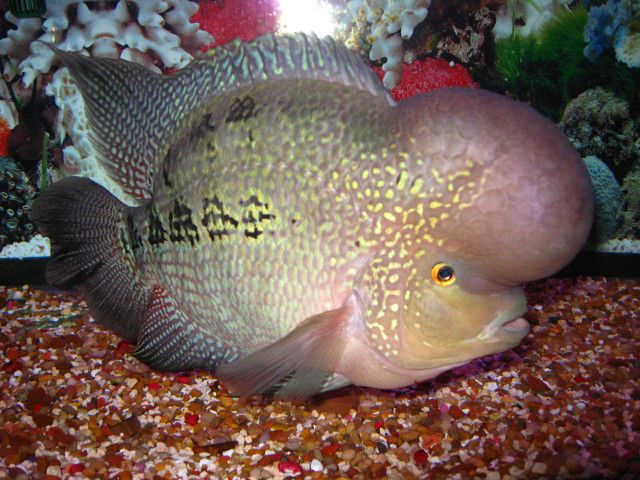 Not only will your flowerhorns grow bigger but they will also be a whole lot healthier and more resistant to disease, all thanks to this best pellet food for flowerhorn.
Not only will your flowerhorns grow bigger but they will also be a whole lot healthier and more resistant to disease, all thanks to this best pellet food for flowerhorn.
What to Look For When Buying a Food For Flowerhorn
Picking food specifically for a flowerhorn can be tricky. Some brands are only for flowerhorns and then there are multi-breed fish foods that might also be beneficial. To help make your task a bit easier, here are a couple of the factors you have to consider:
Protein Content
Flowerhorns are large fish and it is possible for them to grow up to 16 inches in length, maybe even more. To ensure that your fish can reach its maximum growth potential, you need to feed it with a lot of protein. Protein and amino acids will promote the proper growth and development of your flowerhorn.
I suggest that you start by feeding it with a mix of dried shrimp and/or mealworms. They are excellent sources of natural protein. However, it is not good for any fish to just eat protein. It will need other nutrients to function properly.
It will need other nutrients to function properly.
Vegetable Fiber
It is quite possible for fish and other living creatures to starve to death even with a full stomach. If your flowerhorn has been eating nothing but proteins, there will come a time when it will lack the other nutrients needed for it to digest its food. So, it will starve even though it just ate.
To prevent this from happening, you need to give your fish some food that contains vegetable matter, especially fiber. This will balance out the nutrition that your fish is getting, and also improve its digestion.
Pellet Size
If you are buying fish food in the form of pellets, you will need to consider the size of your flowerhorn. If you have young fish, you need to feed them with small pellets.
After that, you can switch to larger pellets especially once they get bigger. Feeding a fully-grown flowerhorn with small pellets will not work as it would likely just ignore them.
Flavor
Although you may not be able to test this parameter yourself unless you are an adventurous eater, you can tell if your fish likes it.
Aside from reading customer reviews, the best way to figure out if your fish will like a certain kind of food is to buy the smallest size packaging available. This way, you will not be investing too much money on something your fish might not even eat.
Price
I know that expensiveness is purely subjective but you have already invested a lot in your flowerhorn anyway. With that said, it just makes sense that you feed it with the most common food for flowerhorn fish that you can afford.
Feeding your fish with cheap fish food may not provide the right kinds of nutrients he needs, which might cause him to get sick. Choose the best kind of food that you can fit into your fishkeeping budget.
Frequently Asked Questions
What can I feed my Flowerhorn to Grow Faster?
All creatures need protein to grow. It is the essential building block for muscle tissue. This means that you should feed your flowerhorn the recommended amount of protein-rich food every day.
Some of the best sources of natural protein that you can give your flowerhorn include freeze-dried shrimps, mealworms, and black soldier fly larvae. There are also plant-based proteins, like soy meal, but it will be a challenge to make picky fish eat them.
How much to Feed a Flowerhorn?
Typically, you should only feed your flowerhorn enough food that it can finish in 5-10 minutes, and then fish out the leftovers immediately. As for how often you feed it, I would usually feed my flowerhorn once in the morning and once early in the evening.
Conclusion
Flowerhorns are among the most beautiful freshwater fishes that you can own. In addition, they are among the most expensive to buy. If you want to protect your investment, you should only feed it with the most popular food for flowerhorn.
Now that you have reached the end of this article, you already have a good idea of how to pick the right food for your flowerhorn. Hopefully, you will find significant improvements in just a couple of weeks.
care, maintenance, reproduction, compatibility, food, photo-review
Inquisitive minds Asian breeders force them every year to create new and unusual aquarium fish. Attempts at interspecific crossing do not stop, but, unfortunately, in most cases, forms with a pale color are obtained, ugly body shape and, as a rule, barren. Flowerhorn - pleasant an exception to this rule, because as a result of hybridization, unusual and attractive fish that can easily breed in aquarium. In our article we will talk about how to properly contain this stunning giant.
Contents
General information
Flower horn, or Flower Horn - an interspecific hybrid of several South American cichlids, obtained breeders from Malaysia. The first crossbreeding attempts began in 1993. year, and five years later, the first flower horns were introduced to the world.
The species that gave rise to this hybrid is not known for certain and is classified as a trade secret. The most likely candidates are: three-spot cichlasoma (Cichlasoma trimaculatum), festa cichlazoma (Mesoheros festae), citron cichlazoma (Amphilophus citrinellus), labiatum (Amphilophus labiatus), rainbow cichlazoma (Vieja melanura).
Why is this fish interesting? The "calling card" of the horn flower is a highly developed growth on the head. It consists mainly of adipose tissue. The inhabitants of Asia are very fond of fish with "hats", because they are a symbol of the god of good luck and longevity. Flower horns, along with arowans, are the "favorites" of the followers of the Feng Shui teachings. An aquarium with these fish, in their opinion, will undoubtedly bring prosperity to its owner.
A fat cap and "hieroglyphs" on the body - a visiting card of flower horns Another one a feature for which this fish is loved is dark spots on the body, which are very resemble hieroglyphs. Individuals with a "lucky" label can cost significant money, but always find their buyer.
Flowerhorn - real show fish. Individuals living in a large species aquarium are guaranteed grab the attention of those around you.
Oddly enough, flower horns are quite unpretentious in care, although beginners should keep these fish not recommended, it is better to start with other easy-to-keep cichlids.
Flower Horns – fish are not shy. When manipulating in the aquarium, they can attack and noticeably bite. But they get used to the owner quickly, allow themselves to be stroked and fed.
Flower horns are distinguished by a variety of colorsIt is worth noting that that there are critics of artificially obtained fish, including flower horn. They consider it inhumane to breed individuals with different anatomical deviations, their maintenance and development in a number of generations. For example, "hat" sometimes increased with the help of chemical compounds.
Ecologists also sound the alarm. And this is due to the fact that in the process of selection, rejected individuals often go to natural reservoirs, where flower horns can become a serious threat to the local ichthyofauna. In some countries, for example Australia, the import of flower horns is prohibited.
Appearance
Horn Flower – very large cichlids, which in suitable conditions can grow up to 30-40 see Body oval, very dense. On the head is a large fatty a bump that sometimes protrudes beyond the head.
On sale you can find flower horns of various colors: red, pink, gold, gray. On the general background of the body there are shiny spots of irregular shape. There are hardly two identical representatives of these cichlids in the world.
Flower horn. Appearance At the flower horns there is an interesting feature: young individuals in the process of growth can change color. This means that a beautiful fry may not retain its juvenile color when will increase. To avoid such surprises, it is recommended to purchase already adult fish, the body color of which has already been fixed. But if you look from on the other hand, there is always a chance to get an individual from a fry with some rare color, so you can take a chance.
Often on the sides a dark band is observed, which can break up into separate spots. The anal and caudal fins are elongated and pointed. tail fin in depending on the breed, it can be round, trapezoidal or slightly forked. In some forms, it is poorly developed.
Large mouth with fleshy lips, always parted.
Life expectancy in an aquarium is about 8-10 years.
Habitat
Flowerhorn is an artificial fish that does not occur in the wild (with the exception of individuals that were accidentally or specially released by the aquarists themselves). The progenitors of the hybrid are the famous cichlids of South America.
Currently time, a wide variety of forms have been obtained, which, depending on the series signs (cone size, color, etc.) are classified into several groups. The most popular of them are KamFa, Malau, Zhen Zhu and Thai Silk.
Care and content
Every lover the horn flowerer must understand that the fish, due to its size, needs a spacious aquarium. It is best if at least 150 liters per individual water. But a fish will truly reveal its beauty only in a huge species aquarium for 800-1000 liters.
Contain these cichlids are recommended in pairs, while it is imperative to monitor the behavior of the male. For various reasons, he can attack the female and inflict damage on her. If you have an aquarium of a suitable size and a desire to keep several pairs of flowers horns, then be sure to zone the territory and install a large number hiding places to minimize conflicts between fish.
Horn flower must be kept in large aquariums Horn flower incompatible with living plants. Almost any green will be eaten or dug up. Therefore, it is desirable to select the soil larger, and make the layer larger, because flovers are very fond of digging at the bottom. For the same reason, any scenery must be firmly fastened and positioned so that, if they fall, they cannot damage the walls of the aquarium. The most commonly used compositions with stones and driftwood.
So big fish, like flower horns, place high demands on quality and purity water. An aquarium needs a powerful external filter and good aeration, as well as weekly water changes up to 20% of the volume with mandatory cleaning of the soil.
Optimal water parameters for maintenance: Т=26-30°С, pH=6.5-7.5, GH=9-20.
Compatible
Flower Horns quite aggressive cichlids, zealously guarding their territory. Ideally, they must be kept in a species aquarium. However, having a large aquarium you can pick up fish neighbors.
Small fish species disappear immediately, because they will be quickly eaten by a voracious predator. Suitable cohabitants will be proportional cichlids: astronotus, Managuan cichlazoma, acara, black pacu, as well as large chain mail catfish - pterygoplichts, plecostomuses.
Flowerhorn in the company of other cichlidsFeeding the flowerer Horna
Flower Horna – snack lovers. They eat quite a lot and almost everything, even live and canned crickets. Some aquarists practice feeding flower horns with homemade feed based on minced meat of warm-blooded animals. TO unfortunately, this method will be the most unsuccessful, because the fish do not absorb well such food that sooner or later will lead to problems with the gastrointestinal tract and may end the death of a pet.
Optimal option for feeding the flower horn - high-quality dry food. They are made from high quality raw materials, contain a lot of protein to meet the nutritional needs of cichlids. A complex of vitamins supports immunity of fish and ensures longevity.
Specialized Tetra LuoHan food has been developed according to the nutritional needs of the flowerer horns. It is a floating balls that contain natural color enhancers and ensure the healthy growth of these cichlids. High digestibility feed components reduces water pollution.
Good fit Tetra Cichlid Color food - it enhances the color of fish with red, yellow and orange flowers and contains the whole complex of nutrients and vitamins. The food will definitely appeal to flower horns.
Tetra Cichlid Sticks Floating All-Purpose Base Food is another suitable option for feeding adult flowerhorns. The high protein content ensures optimal growth of the fish, and the special components in the composition increase resistance to disease and give extra vitality.
Feed the flowerer horns are better in smaller portions, but more often. It is desirable that all food be completely eaten, this will avoid water pollution.
Propagation and breeding
Unlike many hybrid forms, flower horns are mostly fertile, that is capable of producing viable offspring.
Distinguish adult males and females is not difficult. Males are larger, their fat growth is much larger, and the dorsal and anal fins are greatly elongated.
Breeding is easy, similar to most large South American cichlids. Spawning can take place both in general and in a separate spawning aquarium.
It should be noted that the male may be aggressive towards the female if she is not ready to spawn. Therefore, it is necessary to ensure that the male does not injure his girlfriend. It is best to have a transparent partition at the ready, which will allow you to separate the female from the raging male.
For stimulation spawning it is recommended to raise the temperature to 28 ° C, the water must have neutral pH. It is necessary to feed producers abundantly and more often change water. Caviar is laid on a flat stone or similar decoration. The fecundity of the female can reach 1000 eggs. After fertilization, the eggs remain with the male. The flower horns are well developed parental instinct: fish guard their offspring until hatching and 3-4 more weeks after. Incubation of eggs lasts about 3 days.
One month after spawning, spawners and offspring are separated. The fry are fed and sorted by size.
One of the most difficult tasks - the preservation of the breed. Unfortunately, often even from beautiful parents gray and unsightly individuals may appear. The fish take on their color age 5-6 months.
Top 10 live foods for aquarium fish | Aquarium World
If you are looking for the very best food for aquarium animals, most experienced aquarists will agree that there is nothing better than live food. This premium quality food is the closest to what fish eat in nature and has many benefits. The movement of food encourages fish to eat, which is especially useful if they are underweight or growing and need to consume more nutrients than usual.
In addition, hunting enriches your aquarium animals both physically and mentally, and allows you to see interesting behavior that may not be shown when feeding flakes. Finally, live foods are one of the fastest ways to prepare fish for breeding. Learn about these 10 popular live foods and how to grow some of them at home.
1. Artemia baby shrimp
Peacock minnow fry eat brine shrimp When it comes to raising fry or encouraging adult fish to spawn, you can't beat brine shrimp babies. These tiny marine crustaceans are born with highly nutritious yolk sacs filled with protein and healthy fats. To hatch them at home, simply soak brine shrimp eggs in salt water, which will take about 18-36 hours at a water temperature of 23-28°C. When you see hundreds of tiny pink dots floating around, shine a light on the base of the hatchery to attract brine shrimp and separate it from the eggshell.
2. Snails
Sand snails Many fish, such as pufferfish, char and larger South American cichlids, like to eat live snails. The pufferfish's snail shells help grind down its ever-growing teeth so they don't grow back too long. To ensure a constant supply of these aquatic gastropods, establish a separate aquarium or bath as a breeding factory for physella acuta , coil snails and sand snails. They need hard water with higher pH and GH or they may develop holes in their shells. If you have soft water like we do, we prefer to use 3-5 cm of crushed coral as a substrate and then dose mineral supplements such as Wonder Shell or Seachem Equilibrium as needed. We then feed Pleco Banquet Blocks, Nano Banquet Food Blocks and other high calcium fish foods.
3. Acetic oysters
Typically, spawning fish such as tetras, rainbowfish and killifish produce tiny fry that are too small to eat normal fry food. Acetic oysters are harmless white roundworms that are very easy to breed and ideal for feeding fry until they are large enough to eat Artemia babies.
Simply fill a wine or long-mouth bottle with 50% apple cider vinegar, 50% dechlorinated water and a few apple slices. Once the vinegar oysters have multiplied enough, you can harvest them by adding some filter floss and dechlorinated water to the neck of the bottle to make the oysters float out of the vinegar into fresh water. Then use a pipette to remove some of the oysters and feed them to the fish fry.
4. Microworms
Parrot cichlid fry eat microworms Banana worms, annelids and microworms are nematodes or roundworms that are also used as food for live fish. They are slightly larger than vinegar oysters, but still smaller than brine shrimp, so they can be fed as tiny fry. We like to grow these crops in small plastic instant mashed potato containers. Cut a breathing hole in the lid of a plastic container and fill it with filter thread to prevent unwanted pests from entering. To collect them, simply run your finger along the walls of the plastic tub where the microworms have climbed, and then dip your finger directly into the aquarium to feed the fish.
5. Daphnia
These aquatic crustaceans are approximately 1–5 millimeters long and are therefore excellent food for small and medium-sized fish. They reproduce fairly quickly, so to keep the water parameters stable and prevent population declines, we recommend keeping them in as much water as possible. For water changes, use old aquarium water or old dechlorinated water, as these are very sensitive to chlorine.
In addition, prolonged exposure to light and lower temperatures around 20°C are preferred for optimal reproduction. Daphnia are filter feeders, so whenever the water is no longer cloudy with food, give them active dry yeast, green water, or spirulina powder. They are easy to collect by slowly scooping up water with a small-mesh aquarium net.
6. Infusoria
What do most newborn fish eat in the wild? Usually microorganisms such as microalgae, protozoa and invertebrate larvae. Therefore, many fish farmers grow their own cultures of freshwater plankton (i.e. ciliates) to feed the tiny fry. There are many methods, but one of the most popular is to fill a large jar with a few liters of old aquarium water and squeeze some flour out of the filter media.
Add a 3 cm piece of banana peel or ½ teaspoon of instant yeast to feed your ciliates. For faster results, heat the water to 26-27°C and after a couple of days you will see tiny moving dots. If the water turns from cloudy to clear, then the ciliates eat up all the food you provide, and the culture is ready to be harvested. Suck out some water with a pipette and feed it to the fry.
7. Aquatic worms
Live aquatic worms Lumbriculus variegatus are excellent food for bottom dwellers and many breeders find this to be the best way to improve the condition of corridor catfish. They can be difficult to propagate at home, which is why farms in the United States grow large-scale cultures of aquatic worms in artificial ponds. You can usually buy worms either at your local fish store or online directly from farms. When you receive them, pour the worms into a fine mesh fishnet and rinse thoroughly with dechlorinated water chilled to 4-13°C.
Keep the worms in a wide, shallow container to avoid crowding them more than 3 cm high. Pour enough cold dechlorinated water to cover the worms and place the container (without the lid) in the refrigerator. To keep your worms alive until they are fed to your fish, repeat this process of washing the worms every day with pre-chilled, dechlorinated water or they will quickly contaminate the water.
8. Grindal worms and nematodes
Once your fry are done with vinegar oysters and microworms, you can switch to grindal worms (about 0. 5 mm in diameter) and nematodes (about 1 mm in diameter). Start by sterilizing the substrate (such as organic potting soil, peat moss, or coconut fiber) from mites and other pests. You can use the oven to heat the dirt for 30 minutes at 82-93°C, or dampen the substrate and microwave it in 9-minute intervals.0 seconds until it reaches 82-93°C.
Place the substrate in a plastic container or tub and cover until cool; add some dechlorinated water to dampen it some more if needed. Then add a starter worm culture and some food (such as bread and yogurt, oatmeal, instant mashed potatoes, or even fish food) to the surface of the substrate. Place the cup lid on top of the food. Next, cut a breathing hole in the lid of the plastic container and glue a piece of cloth to close the hole and prevent pests from entering. Finally, place the lid on the plastic container.
Grindal worms thrive at room temperature 21-24°C, in which case the nematodes should be stored at around 13°C in a cool cellar or refrigerator. To collect them, remove the lid of the deli cup on top of the food, rub off a few worms with your finger, and dip them into a small bowl of water to rinse them out before feeding the fish.
9. Insects
Large mealworm larvaeInsects and insect larvae make up a large part of the natural diet of many fish, and their exoskeletons provide good roughage that helps improve fish digestion. You can buy food insects like crickets, cockroaches, and mealworms from pet stores, and some people even raise their own cockroach colonies. Dung and earthworms are sold at some pet and fishing stores, and can also be grown at home.
To collect insects from the wild without introducing potential parasites, place a bucket of dechlorinated water outside and wait for the mosquitoes to lay their eggs. Use a fine mesh net to collect mosquito larvae from the surface of the water, and remember to harvest every day or they will turn into adult mosquitoes.
10. Live fish
In general, forage fish are known to have a higher chance of spreading diseases in your tank, and most people don't bother with quarantine of forage fish.



